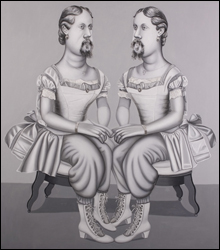
SLIPPERY GENDERS: Hannah Barrett’s The
Chesterly Sisters.
|
In the front window of Stairwell Gallery (504 Broadway, Providence) sit Leif Goldberg’s life-sized coyote-man marionette, which itself is operating a snake marionette, and some of Erin Rosenthal’s Garbage Dancers, little bird or tree rod puppets inside pulped-paper shells that she calls “primitive toys for modern times” and “worry dolls.” “Sound Beings,” the exhibition by the Providence couple and Fort Thunder alums (through April 3), is filled with magical, mystical rainbow-bright visions of and for a worried world.
In Goldberg’s paintings, drawings, and screenprints, a coyote-guy eats at a sushi bar, monster-men play video games in an arcade, and men in boats chase a giant white ox that is pooping a trail of red flame that is setting forests and villages afire. Goldberg’s drawing is sordid and his colors acid, which reinforces the sense of a world gone weird and warped.
Rosenthal’s work feels like an artist concentrating hard to find hope. Nesting Forms is a series of pulped paper nesting dolls in simple elemental shapes: a head, and inside a couple of seed bud-shaped things, and inside them yellow corn, and inside the corn, a bird. She also offers collages of her screenprints, with some additional painting, that depict seated figures, resembling meditating paper doll Buddhas, repeated in attractive alternating colors and kaleidoscoping mandala patterns. In Butterfly Chamber, a person runs out of a series of bubbles or pods that form a cave and touches one of the seated meditation guys, who emerges from a mandala. In that touch seems potential for transcendence.
Connecticut painter Barkley Hendricks won attention in the 1970s for his regal realist portraits of African-Americans painted like icons against flat, color-filled backgrounds. At the Ban¬nister Gallery at Rhode Island College (600 Mount Pleasant Avenue, Providence, through March 28), 20 oval and half-moon-shaped paintings, made between 1998 and 2004, are all landscapes of Jamaica, which Hendricks has been visiting for 25 years. The paintings depict lush, serene rolling mountains and valleys, sweeping vistas of turquoise waters and soft clouds, ocean breezes, cascading waterfalls. Occasionally storms threaten. The only signs of people are a couple houses and a few plowed fields. Hendricks’s brushwork is clumsy, but gold frames give the paintings an aristocratic air, and signify the importance he sees in these places.
Hendricks is African-American himself and some of his titles, like View from the Melon Patch, tease discomforting racial associations. The Alligator depicts a peninsula whose silhouette recalls an alligator, but the title may also reference racist slang for black children as “alligator bait.” “The roads and fields I find myself on and in have many stories to tell beyond my creative motivations and responses,” Hendricks writes in the catalogue to his retrospective exhibit now at Duke University’s Nasher Museum. The landscapes call to mind Caribbean islands’ history as stations of the American slave trade, but also later a locus of black liberty — a slave revolt in Haiti in the 1790s led to the establishment of the first independent black state in the Americas. But mostly these scenes feel like tropical vacation oases. Sit back (the gallery kindly provides a deck chair), grab a cool drink, and relax.
Handsome 19th-century duchesses and severe viscounts in ornate gowns and coats with epaulettes fill Boston artist Hannah Barrett’s 11 The Secret Society paintings at the University of Rhode Island’s Fine Arts Center Galleries (105 Upper College Road, Kingston, through March 30). Their genders are strangely slippery — by appearances, they could be girly men or manly women or some gender-bending mix. They pose in grand chairs or resting on pedestals as if in Civil War-era studio photos, which — cut up and recombined — are one of Barrett’s sources. Barrett has been exploring ideas of sexuality via images of male-female hybrids in her art for several years now, and these catchy, funny, curious black-and-white paintings are among her most beautiful results.
URI also offers “Nazi Persecution of Homosexuals: 1933-1945” (through March 299), a traveling exhibition produced by the US Holocaust Memorial Museum in Washington, DC. The pre-fab poster-like displays offer no original materials or artifacts. The project would make more sense as a book, but as an exhibition it’s likely more successful at drawing attention to its subject. The Nazis arrested more than 100,000 men for homosexuality, and sent about 50,000 to prison in their effort to supposedly cleanse problems from German society and improve its birth rate. It’s estimated that 5000 to 15,000 homosexuals wound up in concentration camps, and hundreds were castrated.